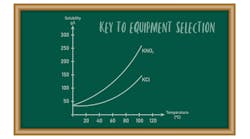Engineering schools are much better at including solids processing in the curriculum than they were when I taught. Unlike other colleges then, at least my university had more than one type of crystallizer. Our methods were crude but stressed fundamentals that later served us well.
For example, I assigned an experiment that required getting the flow rate of a slurry using an instrument in the process. My challenge to the class was: How do we know if the instrument is accurate? My students thought it over and finally, in despair, concluded that the old bucket-and-stopwatch method would work. They had travelled all the way from the Orient to apply the same method used at home. Don’t dwell on the negative in such situations, though — knowing the basis of your actions actually makes a bad experience a good one. We must look at those past episodes to progress, especially in solids processing.
When I worked in industry, my chemist colleagues often remind me that I’m a chemical engineer, not a chemist. However, that never has stopped me from putting in my two cents. I haven’t forgotten my chemistry and have used it in a very profitable manner.
We were developing an emissions reduction process that would use conventional tailgas-cleaning methods. It was very expensive and not certain to reach the goal. Many years earlier, I had worked on a particulate control project and discovered that cyclones hold a large inventory of solids that could cause the device to clog up. However, if the solids are reactive, the cyclone would consume them. Our emission was very reactive and only became a fine particle in the combustion process. Designing the cyclone to maximize residence time allowed the particles to react and agglomerate there. The project cost less than 20% that of the original plan and met all goals. Don’t forget about chemistry.
Many companies commonly overspend the budget on equipment, rationalizing that the extra expense promises longer life and additional features. I even heard one engineer say that a dollar spent on capital resulted in a dollar of profit. That’s certainly no longer the case. So, instead, spend the time during development to check for alternative routes that can eliminate poor equipment choices and bad experiences. For instance, in my September 2018 column (“Conquer Crystallization Challenges”), I outlined five options to explore when looking at a new crystallization process. Often, a chemist will focus exclusively on tried-and-true methods and fail to consider other options. Normally, generating super-saturation and maintaining a slow growth is the standard. It’s easy to overlook seeds and sonication, as well as removing excess nuclei to raise the particle size distribution (PSD). Sometimes, the extra time to make a large crystal isn’t worthwhile when you can easily filter and agglomerate a smaller size to produce a better bottom line.
The trouble with solids is that fines don’t follow the other particles and can even cluster to behave like a larger particle. You can prevent segregation by doing the correct shear-testing experiments and knowing the frictional characteristics of your particles. We had a bin that had been used on another product. The two materials had roughly the same particle size, density and PSD, so the plant felt the bin would work with the new material. Well, it didn’t. Addition of vibrators didn’t help. The facility was about to abort the conversion when I noticed the discharge rotary valve didn’t have a vent and was feeding solids erratically. It looked like the rotary valve was fluidizing the solids, which then collapsed. We cut off the cone and fashioned a crude vent/hopper. Lo and behold, the material flowed properly. It turns out the PSD was more of a x2 shape and had more fines at the low end of particle size than the previous material. Shear testing of the new material would have shown the need for the larger opening ahead of the rotary feeder and that the vibrators were a waste of time.
Getting good results in solids processing requires experience and, sometimes, we can learn from the bad to produce a good result.



